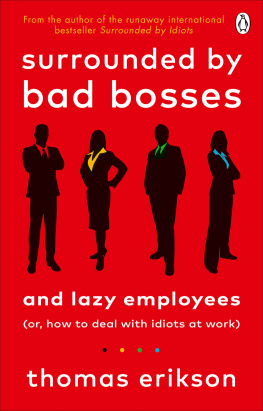Contents
Guide
Pagebreaks of the print version

The author and publisher have provided this e-book to you for your personal use only. You may not make this e-book publicly available in any way. Copyright infringement is against the law. If you believe the copy of this e-book you are reading infringes on the authors copyright, please notify the publisher at: us.macmillanusa.com/piracy.
This book is based on thirty years of experiencefirst as a manager, then training other managers in leadership, and finally becoming a manager again. Much of what you will read is my interpretation of the various theories and models that have been developed to deal with the complicated and sometimes difficult-to-understand process called leadership.
You probably wont agree with everything you read, that would be impossible, but the more open your mind, the easier it will be for you to absorb what Im hoping to convey. There are many other theories and methods that I dont discuss for building functional dialog in the workplace. And doubtless more ideas will be developed in the coming years; few subjects are as discussed as leadership. In this book, Ive focused on the methods that Ive successfully used myself. To make this book as helpful as possible, Ive tried to be as concrete as I could. Feel free to read the book with a notebook next to you and a pen in hand. Or why not make your notes directly in the book?
Everything you will read is based on the techniques and tools Ive found are crucial to making interactions between employees and their managers as smooth and efficient as possible. In my experience, its always better to have some kind of leadership plan instead of no plan at all. Youre about to take part in mine.
Finally, think of this book as an introduction to the subject of leadership. In three hundred pages, I dont have time to do more than scratch the surface. But if you want to know more, I recommend going to the resources section at the back of the book. Thats exactly what I did when I first immersed myself in what has become the great interest of my life.
Enjoy reading.
Thomas Erikson
Why You Should Read This Book
Lets get straight to the point: the world is full of bad bosses. Team leaders, group leaders, departmental managers, unit managers, deputy managing directors, managing directors, and the bosses of managing directors. Sometimes the boss is a chairman of the board in a Fortune 500 company, and sometimes the same chairman is at the head of a local sports team. At every level, in all types of organizations, there are bosses who have ended up in the wrong place and cause problems for themselves, who cause problems for their staff, who are incompetent, and who are nave. There are bosses who are far too nice, and there are ones that are just plain mean. Some cant manage to learn the names of their staff, and some just sneak away from their own responsibility. Some of them are so incompetent that the company would have been better off without them.
These are the superfluous bosses. The ones that arent really needed and that the rest of us would manage better without. Who dont contribute anything at all, except for headaches and stress.
It used to be that the bosss responsibilities were simple: to lead and say who should do what. If you managed that, then you were doing your job. A good friend of mine often quotes his own father when it comes to leadership: Never become the boss, because youll end up doing everything yourself.
Why is it so hard to define a bosss role? Is it really that difficult? Perhaps its the simplest thing in the world? If you just sit down and give it a shot.
And the bosses who function brilliantly in their roleswhat do they understand that others dont? Is there actually a secret?
This book is divided into two parts. The first, Surrounded by Bad Bosses, describes how hard it is to do your job when you have a bad boss. Here we will look at examples of poor leadership and what you, as an employee, can actually do about it.
This section isnt designed for the reader who is already a competent boss and actually knows what theyre doing. But if you are a boss and you think theres still a lot you can learn about how to best manage your employees, you might find this section valuable. The second part of the book is Surrounded by Lazy Employees. Because there are some workers who arent exactly in the running for employee of the month. Everybody has different strengths and weaknesses. Read on to find out how you can you help your staff discover their potential and find their genuine driving forces.
But for those of you who really wonder why on earth your boss behaves like thatjust keep on reading. Youll learn the reasons why some bosses function welland others dont function at all.
Surrounded By Idiots?
A few years ago, I wrote a book called Surrounded by Idiots. Its about differences in communication styles, and why certain people can be so difficult to understand. I introduced William Moulton Marstons DISC system which, over time and with further development by others, evolved into a simple model based on four colors: Red, Yellow, Green, and Blue. The point was to show how you can better understand people who dont function or communicate like you do. Of course, the model doesnt answer all the questions when it comes to how we function day to day, but it does give us a good starting point for discussions and ways to institute change. A person is rarely just one color, but most often has elements of two or even three.
Here are a few things to know about the DISC model:
- The DISC model cannot explain everything about an individuals behavior.
- There are other models that seek to explain behavior, but I use this one as a starting point because it is pedagogically simple to grasp.
- There are more pieces of the puzzle than the colors to map various behavior patterns.
- The DISC model builds upon thorough psychological studies, is used throughout the world, and has been translated into fifty different languages.
- Historically, there have been similar models in different cultures, such as the system of the four humors created by Hippocrates, who lived in ancient times, around 2,500 years ago.
- Approximately 80 percent of all people have a combination of two colors that dominate their behavior. Around 5 percent have only one color that dominates behavior. The rest are dominated by three colors.
- Entirely Green behavior, or Green in combination with another color, is the most common. The least common is entirely Red behavior, or Red in combination with one other color.
- There can be differences in behavior between the sexes, but I do not deal with the gender perspective in this book.
- The DISC model cannot be used to analyze ADHD, Austism spectrum disorder, borderline personality disorder, or other diagnoses.
- There are always exceptions to what I outline in this book. People are complexeven Red people can be humble and Yellow people can listen attentively. There are Green people who can handle conflict because they have learned how to do it, and many Blues understand when its time to stop double checking that the documents are correct.
- Everything that I talk about is connected to personal insight and awareness. Problems arise when personal insight is limited.
- My own colors are Red and Blue with a bit of Yellow. No Green to mention. Sorry.








